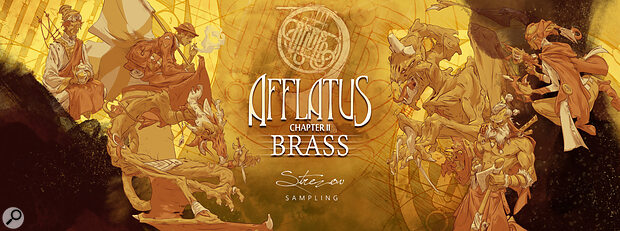Rating: ★ ★ ★ ★ 4/5 Stars
The tonal characteristics of orchestral brass instruments are notoriously difficult to capture and reproduce in sampled form. Any library wishing to encompass the full gamut of articulation and tonal colour is going to have to be fairly large, which makes Afflatus Chapter II : Brass by Strezov Sampling appear quite sensible, at an installed weight of 117GB. The remit, as expressed by George Strezov, is to provide a library that can handle contemporary scoring, with reverence toward the great scores from the big screen. This also explains the multi‑preset aspect of some of the patching, with references to ‘Imperial Brass’ and ‘Barbarian Brass’.
Away from these multi‑presets, the brass catalogue is extensive. Beginning with the French horn section, capture has been undertaken at the solo, two‑player and four‑player levels. This follows symphony orchestra convention, providing a bewildering array of articulations, tonguings and instrumental colours, both muted and senza sord. The dynamic range of the sampled set glides from subtle pianissimo to an outright onslaught, should you need to appropriately reflect any on‑screen nastiness. One revelation, which has made its way across from the Afflatus String package, is polyphonic legato; this is not only a huge timesaver when producing a performance in your DAW, but also incredibly convincing. Even across relatively large interval movements, it really does sound authentic, and is included alongside the more traditional Sustain and Mono Legato modes, with mode switching available from the patch panel.
One revelation, which has made its way across from the Afflatus String package, is polyphonic legato; this is not only a huge timesaver when producing a performance in your DAW, but also incredibly convincing.
Also included in the library are cinematic favourites like the cimbasso and bass trombone, as well as a highly convincing tuba section, which just leaves the trumpet and trombone sections. These are provided in solo and three‑player units, with metal and useful carbon mute capture, should you crave a softer con sord colour. The three‑player units also receive the polyphonic legato treatment, mirroring the horns, though there are some areas of sonic weakness in these sections. Directional brass instruments, with their brighter tone, don’t always fare so well with close miking, and certainly with my trombone‑player’s ears, I would suggest that backing off the close mic signal affords a better overall colour which sits better with the orchestral palette. It also lessens the presence of the occasional tonal blemish, which seems to be present on some louder samples.
As a package, Afflatus Brass is certainly comprehensive, but some sections arguably require a degree of listening and adjustment to get the best from them. The dynamic control is also exceptional throughout, but even hosted on an up‑to‑date Mac, I had to back off the sample buffer size to 256 samples to prevent audible glitching while altering dynamic range in real time. Afflatus Brass is clearly a powerful and consuming beast, in more ways than one!
€658.80
€549


